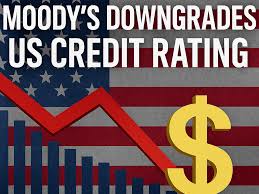
Moody’s Investors Service on May 19, 2025, downgraded the credit rating of the United States from Aaa to Aa1, its first downgrade since 1917. The action sent shockwaves through global financial markets, raising concerns about the country’s fiscal health and how it will impact investors,
The Times
+1
The Guardian
+1
Why Moody’s Downgraded the U.S.?
Moody’s included the following key drivers of the downgrade:
Increasing Debt Levels: The United States federal debt is projected to be 134% of GDP in 2035 versus 98% during last year. This growth is driven by higher interest payments, entitlement programs, and low tax collections .
The Times
+1
Reuters
+1
AP News
Political Gridlock: Congress’s persistent political polarisation has put a lid on efforts to have effective fiscal policies, and this has made many wonder if the government is capable of keeping its finances in order.
CNBCTV18
+1
CNBCTV18
+1
Increased Borrowing Costs: The downgrading has led to an increase in U.S. Treasury yields, with the yield on the 30-year bond jumping over 5%, a record since November 2023. This increase in costs of borrowing shows investors’ alarm regarding the country’s fiscal direction.
The Times
+1
Reuters
+1
Market Reactions
The downgrade has had immediate effects on global financial markets:
Stock Markets: American stock futures fell sharply, with Nasdaq futures falling 1.5%, reflecting investor anxiety.
AP News
Bond Markets: U.S. Treasury yields rose, with the 30-year yield breaking above 5%, illustrating higher costs of borrowing and concerns about economic stability.
The Times
+2
The Guardian
+2
Reuters
+2
Currency Markets: The U.S. dollar lost strength compared to major currencies, illustrating reduced investor confidence in U.S. assets.
The Guardian
Implications for Investors
The downgrade has a number of implications for investors:
Increased Borrowing Costs: Higher Treasury yields have the potential to result in higher borrowing costs across the economy, from mortgages to corporate loans.
Rio Times
Market Volatility: Initial market reactions foretell greater volatility, which will likely impact investment portfolios, particularly those that are concentrated in U.S. assets.
Currency Fluctuations: Deterioration of the U.S. dollar might affect cross-border investments and thus could be a factor in altering global capital flows.
research-center.amundi.com
Looking Ahead
While this downgrade is an important event, it is useful to consider the broader context:
Reserve Currency Status: The U.S. dollar remains the world’s reserve currency, which continues to support demand for U.S. Treasury securities.
research-center.amundi.com
Policy Reactions: Coming monetary and fiscal policy responses will be key to dealing with the problems laid bare by the downgrade and regaining investor confidence.
In conclusion, the Moody’s downgrade of the credit rating of the U.S. points to the urgency for wide-ranging fiscal reforms. Investors must remain watchful, paying close attention to policy directions and market reactions to cope with the evolving economic landscape
Leave a Reply